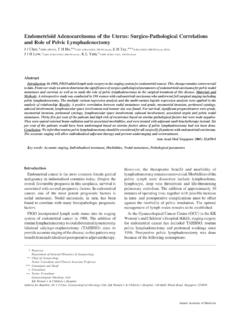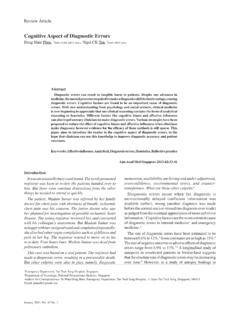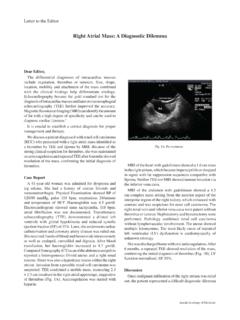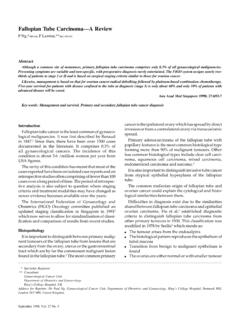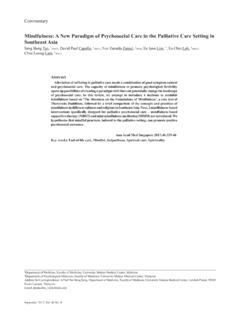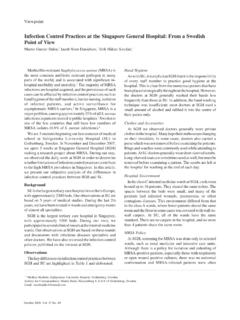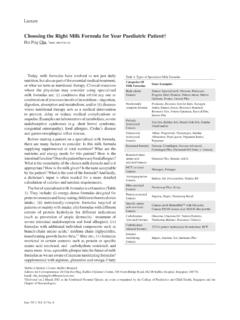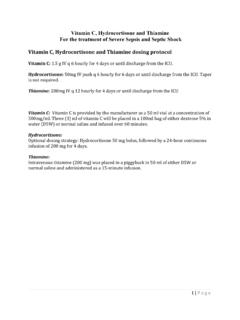Transcription of Attitudes Towards the Elderly among Singapore …
1 October 2009, Vol. 38 No. 10 students Attitudes Towards the Elderly Seng Kwing Cheong et al857 Attitudes Towards the Elderly among Singapore medical StudentsSeng Kwing Cheong,1 MBBS, M Med (Fam Med), FCFP, Teck Yee Wong,1 MBBS, M Med (Fam Med), MPH, Gerald CH Koh,2 MBBS, M Med (Fam Med), FCFPI ntroductionSingapore s population is ageing rapidly. As of the year 2000, of Singapore s population was aged 65 and above, while was aged 60 years and In the next 2 decades, the number of the Elderly is expected to increase by more than 3 times the present level to over 1 million With a greater proportion of the Elderly , our doctors will very likely be treating more Elderly patients over the years. The burden of chronic, non-communicable diseases is also likely to As more of our older persons consume more healthcare services, healthcare providers will have to be more aware of the challenges they will face to appropriately care for this segment of the population.
2 For example, care needs to go beyond treatment of the Elderly who have lost their health to include disease prevention, and maintaining function and independence in older Similarly, the containment and optimal management of chronic conditions will require a strong emphasis on patient professionals are reported to be particularly susceptible to ageist stereotyping because of their increased exposure to Elderly and infi rm A study among oncology health professionals showed persistently negative Attitudes Towards Elderly people regardless of profession, gender and clinical For medical trainees, the existing literature reveals inconsistent results, with several studies reporting negative Attitudes of medical trainees Towards old people, particularly fi rst-year medical students ,6-8 while others showed neutral or favourable Ageist Attitudes Towards older persons can negatively affect patient care, resulting in complications in diagnosis and treatment14 and dissatisfying an increasing proportion of the Elderly in the population in the near future, it is important that medical students possess the correct attitude and knowledge Towards older persons.
3 Provision of care for older persons is an important aspect of undergraduate medical Examining medical students Attitudes about the Elderly will provide valuable information when planning geriatric education in medical far as we know, few studies on medical students Attitudes Towards the Elderly have been conducted in Asia. AbstractIntroduction: It is important that medical students possess the correct attitude Towards the Elderly and not have an ageist attitude. This is because they will be caring for an increasing proportion of Elderly patients. We thus sought to assess the Attitudes of our medical students Towards the Elderly . Materials and Methods: We conducted a cross-sectional study assessing the Attitudes Towards the Elderly of 225 fi rst-year and 135 third-year students using a self-administered questionnaire that incorporated the Kogan s Attitudes Toward Old People Scale (KAOP).
4 Elderly people were defi ned as those aged 65 years and above for this study. Results: The majority of fi rst- ( ) and third-year ( ) medical students had positive Attitudes Towards Elderly people (KAOP score above 102). KAOP scores were not signifi cantly different regardless of seniority ( medical student year), gender, race, household income, or having a doctor-parent. Although the mean KAOP score of third-year students was higher than that of fi rst-year students , this was not signifi cantly different (P = ). Conclusions: medical students in Singapore have a positive attitude Towards the Elderly . It is important that their medical cur-riculum continues to have an increasing geriatric component in view of the increasing numbers of older persons that they will be caring for due to the ageing Acad Med Singapore 2009;38:857-61 Key words: Curriculum, Geriatric, Kogan 1 Division of Family Medicine, University Medicine Cluster, National University Health System, Singapore 2 Department of Epidemiology and Public Health, Yong Loo Lin School of Medicine, National University of Singapore , SingaporeAddress for Correspondence: Dr Cheong Seng Kwing, Division of Family Medicine, University Medicine Cluster, National University Health System, 16 medical Drive, Blk MD3, Singapore 117597.
5 Email: Article858 Annals Academy of Medicine students Attitudes Towards the Elderly Seng Kwing Cheong et alWe thus sought to study this potentially important aspect of patient care among our future and MethodsSettingWe conducted a study among fi rst- and third-year medical students for the academic year 2007/2008 at the Yong Loo Lin School of Medicine, National University of Singapore (NUS). This was part of a larger survey that we conducted, the Study of Personal Health Practices & Attitudes /Perceptions of medical students Towards General Practice, the Aged and Preventive Medicine (GAP study). First-year students had just started medical school 3 months prior to the study and only had introduction to pre-clinical subjects (via lectures and tutorials). The third-year students were surveyed after introductory lectures on geriatric medicine and exposure to Elderly community healthcare services during their 4-week Family Medicine (FM) was a self-administered questionnaire.
6 To assess respondents attitude Towards the Elderly , we used the Kogan s Attitudes Toward Old People Scale (KAOP).18 This is a 34-item tool consisting of 17 positively framed and 17 negatively framed statements, covering characteristics such as residential patterns, cognitive style, personal appearance, personality and discomfort with Elderly people. Elderly people referred to people aged 65 years and above. Respondents were asked to indicate the level to which they agreed or disagreed using a 6-point Likert scale (strongly disagree, disagree, not sure but probably disagree, not sure but probably agree, agree, and strongly agree). To obtain a score, the values of the negatively framed statements were reversed and tallied in with the positively framed statements. The range of scores was 34 to 204 with higher scores representing a more positive attitude.
7 The score indicating a neutral attitude was 102. Pilot Study A pilot study to test out the questionnaire was done with 12 third-year students during their FM posting in May 2007. The questionnaire included 14 items including demographic data and the KAOP. Minor adjustments were made following feedback from the students after the pilot analysed the data using SPSS Version (SPSS Institute, Chicago, IL). Chi-square analysis was used to compare proportions and independent t-test analysis was used to compare continuous variables for statistical signifi cance. Signifi cance level was set at P < Characteristics and Mean KAOP Score (Table 1)The respondents consisted of 225 fi rst-year and 135 Table 1. Demographic Characteristics of Study ParticipantsCharacteristics First-year medical students Third-year medical students X2 n = 218 [ n (%) ] n = 124 [n (%) ] P value Mean age (y) (SD) ( ) ( ) Sex [n (%)] Male 121 ( ) 69 ( ) Female 97 ( ) 55 ( ) Ethnicity [n (%)] Chinese 201( ) 105 ( ) < Non-Chinese 17 ( ) 19 ( ) Household income [n (%)] <$2000 29 ( ) 9 ( ) >$2000 189 ( ) 115 ( ) At least one doctor parent [n (%)] No 196 ( ) 110 ( ) Yes 6 ( ) 6 ( ) KAOP Score >102 214 ( ) 123 ( ) Mean KAOP Score (SD) ( ) ( ) KAOP: Kogan s Attitudes Toward Old People Scale; SD: standard deviationNumbers for each item may not add up to the total number of students due to missing valuesOctober 2009, Vol.
8 38 No. 10 students Attitudes Towards the Elderly Seng Kwing Cheong et al859third-year medical students . After accounting for missing or incomplete responses, we obtained 342 completed questionnaires (95%). The percentage of completed questionnaires obtained was and for fi rst- and third-year medical students , majority ( fi rst year, third year) of our medical students had positive Attitudes Towards the Elderly (KAOP score above 102). Although the mean KAOP score of third-year students was higher than that of fi rst-year students , this was not signifi cantly different (P = ).Differences in KAOP Scores within medical Student Year (Table 2)Table 2 lists the differences in scores between different characteristics within each student year. Within each medical student year, KAOP scores were not signifi cantly different regardless of gender, race, household income, or having a doctor-parent.
9 Because of the small number of students who had negative Attitudes , we could not analyse their characteristics is heartening to fi nd that the overwhelming majority of our medical students had positive Attitudes Towards Elderly people regardless of each student s seniority ( medical student year), gender, race, household income, or parent being a doctor. Our study contrasts with other studies in the literature, where medical students have apparently had at best, a moderately positive,19 neutral or even negative attitude Towards Elderly ,20,21 One possible reason for this positive attitude among our students is the observation that respect for older persons is a notable tradition among people of East Asia, of which Singapore is a A study of Singaporean undergraduate social work student Attitudes reported that it was necessary to consider the impact of Confucian ethics on Singaporean students when assessing their Attitudes Towards older Moral codes and social norms are likely to be very much infl uenced by Confucianism in Singapore .
10 Where three quarters of the population are of Chinese The traditional basis for elder respect includes the Confucian teaching of fi lial piety25 which prescribes for older persons to be respected and honoured by their offspring. There is a sense of obligation involving protection, care and fi nancial support Towards parents and ancestors. It also stresses status differences among persons based on gender and Even among Singaporeans of non-Chinese ancestry, such as the Malays, Indians, Pakistanis and Sri Lankans, where Confucianism is not practised, fi lial responsibility is also emphasised and possible reason is that many of the present Elderly are active within their family arena, such as looking after their grandchildren, cooking and helping to keep the family traditions This could have the effect of letting the young witness fi rst-hand the active roles and functions older adults serve within the the global ageing trend, medical curricula should promote students ability to care for older adults by having suffi cient representation of the Elderly .
